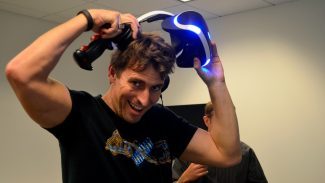Everyone in the VR industry can envision a world in the next 10 years that’s radically changed by virtual reality. From healthcare, education, social, training, cinema, gaming, and more, VR has a lot of Killer Use-cases. But it seems most of the industry is in agreement that the Killer App—a single, platform-defining piece of software that compels buyers—has not yet arrived. Sony’s Richard Marks weighs in on how we might come to find it.
Every day this week leading up to the 2017 Game Developers Conference in San Francisco, we’re featuring insights on the hunt for the killer app from virtual reality’s leading companies. Today we hear from Richard Marks, Senior Research Engineer on R&D at Sony Interactive Entertainment.
Dr. Richard Marks
Marks heads the PlayStation Magic Lab within Sony Interactive Entertainment’s Research & Development group. Magic Lab was founded by Marks to push the boundaries of play by exploring how technology can be used to create new entertainment experiences. Marks joined PlayStation in 1999 to investigate the use of live video input for gaming and to develop new interactive user experiences. He helped create the EyeToy and PlayStation Eye cameras, as well as the PlayStation Move controller. Most recently, Marks and his team have been involved with PlayStation VR, experiments with eye tracking technology, and other innovations. He received a Bachelor of Science in avionics from the Massachusetts Institute of Technology and a doctorate in the field of underwater robotics from Stanford University.
Road to VR:
What traits do you think VR’s Killer App needs to have?
Marks:
I don’t believe there will be a single ‘Killer App’ for VR. It is too broad a medium to have just a single app that defines it. If you enjoy sci-fi, you’ll most likely enjoy sci-fi in VR. If you enjoy history, you’ll most likely enjoy history in VR. Virtual reality truly is a new medium, and the idea that there could be a single Killer App discounts it huge potential scope.
But I do believe there will be a collection of ‘Hero Apps’ that help drive adoption and interest, much like we’ve seen in the past with other mediums. These Hero Apps will successfully leverage the capabilities that are unique to VR, in a content area that has broad appeal. The two most important capabilities of VR are presence (being in a different place) and co-presence (sharing a different place with others).
There are multiple technologies that can be used to achieve these capabilities, and a big challenge for mass adoption of VR is the significant hardware required—so accessible (e.g., low cost, low encumbrance) approaches that retain high quality will have the greatest success at reaching a wide audience. Of course, we believe accessibility is one of the biggest advantages of PlayStation VR; it “just works” with over 53 million PS4 consoles in consumers’ homes, making it easier for someone to jump into VR.
Road to VR:
If you had to make a bet, which sector of VR would you predict as the place where the first Killer App emerges?

Marks:
The entertainment sector, including gaming, is likely to have the earliest success because VR is being added to expand the offerings. Also, game developers are already practiced at creating interesting virtual worlds; I’ve heard many game designers say that VR is the medium that lets them finally realize the visions they’ve been trying to create.
We are already starting to see the emergence of several Hero Apps. Horror is a genre that leverages VR presence, and many people recently have been enjoying the visceral experience of Resident Evil 7 (2017) in VR. And I’ve heard many people say that the Star Wars Battlefront Rouge One VR Mission (2016), while not a full game, is their favorite VR experience so far.
I also believe in the near term, social gaming will be the most successful implementation of social VR because it provides an interesting focus, a “raison d’être” for social interaction in VR, rather than something open-ended such as [a VR chat room].
Road to VR:
Do you think VR’s Killer App will launch in 2017?
Marks:
I strongly believe 2017 will introduce a Hero App (game) that leverages VR co-presence for a new level of interaction beyond any we’ve ever seen in games before, and that is what I’m looking forward to this year.








